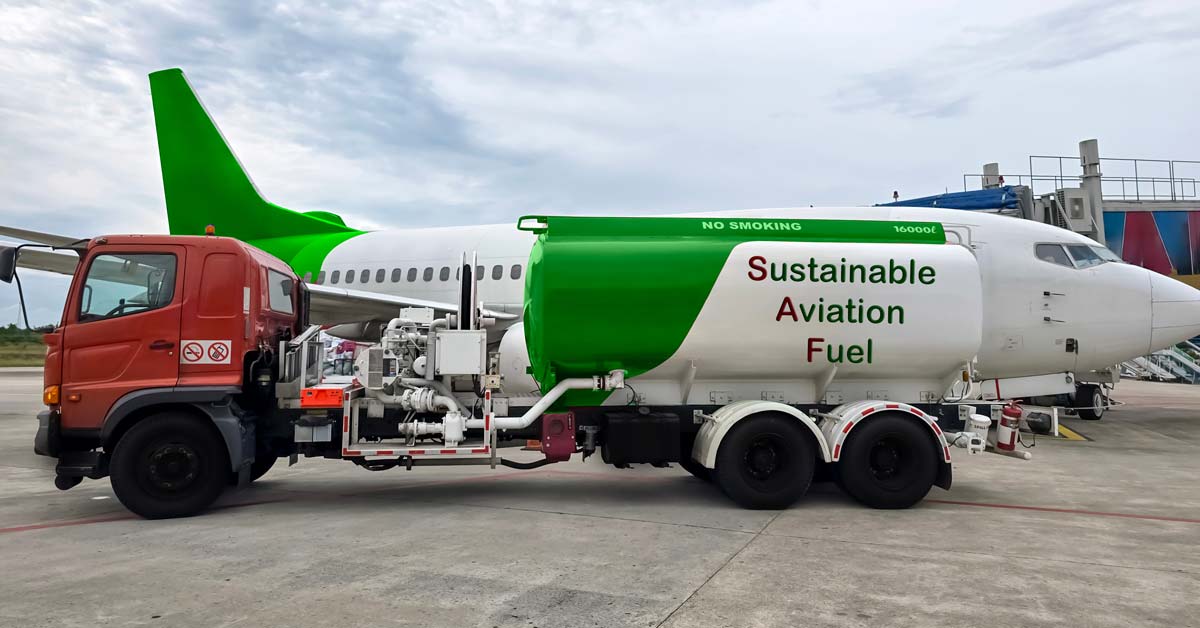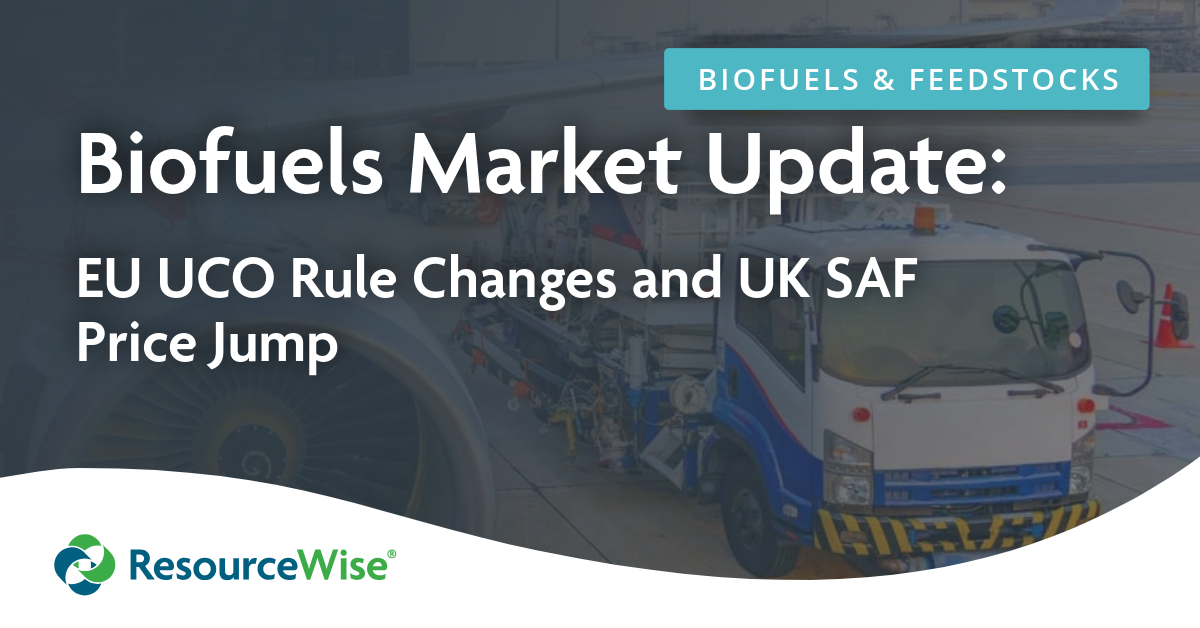3 min read
Why Sustainable Aviation Fuel Needs More Than Mandates
ResourceWise
:
Jun 12, 2025 8:59:25 AM

The aviation sector faces a serious challenge on the road to decarbonization. While other industries begin to make headway in cutting emissions, aviation remains one of the toughest to succeed. High energy demands, long fuel chains, and limited zero-emission technologies all complicate the picture.
To make true progress, sustainable aviation fuel (SAF) stands out as the most promising near-term solution to decarbonize flight. Yet despite the promise and potential of SAF, production growth and policy design have not yet caught up with ambition.
SAF Production Up, But Not Nearly Far Enough
According to the International Air Transport Association (IATA), global SAF production is expected to reach 2 million metric tons (mt) in 2025. While this may sound like progress, it accounts for just 0.7% of the roughly 300 million mt of jet fuel consumed annually.
Even this small percentage of SAF comes at a cost, with an estimated $4.4 billion added to the global jet fuel bill. That breaks down to around $2,200 per ton of SAF. This price goes far above the current market premium of about $1,200/ton for jet fuel.
With pricing levels so high, it’s no surprise that SAF adoption remains a somewhat niche area across the greater aviation fuel sector. But how can the market bridge the gap and provide space for SAF to compete globally?
High Prices Misalign with SAF Objectives
At the core of the problem is a mismatch between policy ambition and market readiness. The discrepancy is particularly evident within the European Union.
The EU’s domestic SAF mandates are driving demand. Beyond that, however, compliance costs are skyrocketing and potentially slowing the roll.
For example, the EU’s 1 million mt SAF mandate in 2025 will cost an estimated $1.2 billion at market prices. But an additional $1.7 billion in compliance-related costs is expected on top. According to IATA, that extra compliance burden could have purchased 1.5 million more tons of SAF, saving nearly 4 million tons of CO₂.
IATA’s criticism comes down to policy. Governments are enforcing mandates before building sufficient safeguards and supportive market conditions. Ultimately, this undermines the very decarbonization efforts those mandates are meant to accelerate.
Read More: IATA Launches Global SAF Registry, But Can We Reach Its Targets?
Three Areas for Policy Reform
While the intent is sound, the strategy needs some work to yield meaningful change. To address this imbalance, IATA has outlined three key areas for policy focus.
1. Redirect Fossil Fuel Subsidies Toward Clean Alternatives
Governments around the world still provide nearly $1 trillion annually in fossil fuel subsidies. Redirecting even a fraction of that to support low-carbon alternatives like SAF could dramatically shift market dynamics.
This is IATA’s strongest argument, and it sees broad support across the climate policy space. A subsidy shift would help renewable fuel producers compete with entrenched oil majors on more equal footing.
2. Develop a Cohesive Energy Strategy
IATA also calls for an integrated policy approach that explicitly includes SAF in broader energy planning. While this step is critical, the recommendations remain vague and create more challenges.
A more comprehensive strategy would not only support SAF but also invest in supporting infrastructure, co-products, and renewable electricity. These additions are especially important for eSAF which requires green hydrogen produced from clean power.
The good news is that some progress is already being made in aligning biofuel mandates with feedstock development. For instance, the rise of waste oil collection networks and biogas systems can help feed into SAF production.
3. Ensure CORSIA’s Effectiveness
IATA also champions CORSIA (Carbon Offsetting and Reduction Scheme for International Aviation) as the current global mechanism for aviation emissions compliance.
While CORSIA was a necessary first step, its structure is widely seen as inadequate. It relies heavily on low-cost offsets from unrelated sectors, allowing airlines to purchase carbon credits at around $3 per ton. This number is far below the $300+ per ton cost of carbon savings achieved through SAF.
This disparity has led many to question whether CORSIA, in its current form, incentivizes real decarbonization or simply enables greenwashing.
In situations like this, it’s important to remember what decarbonization is all about at its most fundamental level. If we’re not achieving true emissions reduction, we’re not making any actual progress forward.
Where IATA Stands
IATA’s position is somewhat conflicted.
The organization rightly recognizes the need to decarbonize aviation. At the same time, however, it acknowledges the high costs its members face to make that happen.
Policy suggestions are directionally helpful, but they are modest in scope and lack urgency. For the transition to truly accelerate, IATA must lead more boldly, moving from criticism of current initiatives to proactive engagement.
That means working closely with member airlines, SAF producers, regulators, and financiers to achieve several objectives:
- Scale production at a pace and scale much higher than current levels
- Improve transparency in all operations
- De-risk investment in the sustainable aviation sector
What will the future look like to achieve these objectives? It begins with supporting smarter mandates that scale in step with supply capability and infrastructure. Additionally, the group must push for stricter sustainability criteria to ensure that the SAF used is both renewable and environmentally responsible.
The Way Forward: Caution Without Stagnation
The SAF story is still in its early chapters. There’s no question that it will play a vital role in aviation’s decarbonization. But without effective policy frameworks, well-structured financial incentives, and stronger coordination, that role may remain limited for too long.
IATA has a real opportunity to shape this future. In order to get there, the group must evolve from a watchdog into a leader.
The goal is to help protect its members from catapulting costs, of course. But it must go further than that.
IATA must help its members invest in solutions that make economic and environmental sense. Beyond its words of warning and criticism, it has the potential to lead us much faster toward achieving emissions goals in the aviation sector.
Subscribe to the ResourceWise blog today for critical news and inudstry updates—delivered straight to your email.





